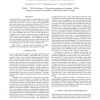Free Online Productivity Tools
i2Speak
i2Symbol
i2OCR
iTex2Img
iWeb2Print
iWeb2Shot
i2Type
iPdf2Split
iPdf2Merge
i2Bopomofo
i2Arabic
i2Style
i2Image
i2PDF
iLatex2Rtf
Sci2ools
ICASSP
2011
IEEE
2011
IEEE
Automatically finding semantically consistent n-grams to add new words in LVCSR systems
This paper presents a new method to automatically add n-grams containing out-of-vocabulary (OOV) words to a baseline language model (LM), where these n-grams are sought to be grammatically correct and to make sense according to the meaning of OOV words. First, this method consists in determining the word sequences, i.e., n-grams, in which the usage of a given OOV word is the most semantically consistent. Then, conditional probabilities of these n-grams have to be computed. To do this, semantic relations between words are used to assimilate each OOV word to several equivalent invocabulary words. Based on these last words, n-grams from the baseline LM are re-used to find the word sequences to be added and to compute their probabilities. After augmenting the vocabulary and launching a recognition process, experiments show that our method results in WER improvements which are comparable to those obtained using a state-of-the-art open vocabulary LM.
| Added | 20 Aug 2011 |
| Updated | 20 Aug 2011 |
| Type | Journal |
| Year | 2011 |
| Where | ICASSP |
| Authors | Gwénolé Lecorvé, Guillaume Gravier, Pascale Sébillot |
Comments (0)

